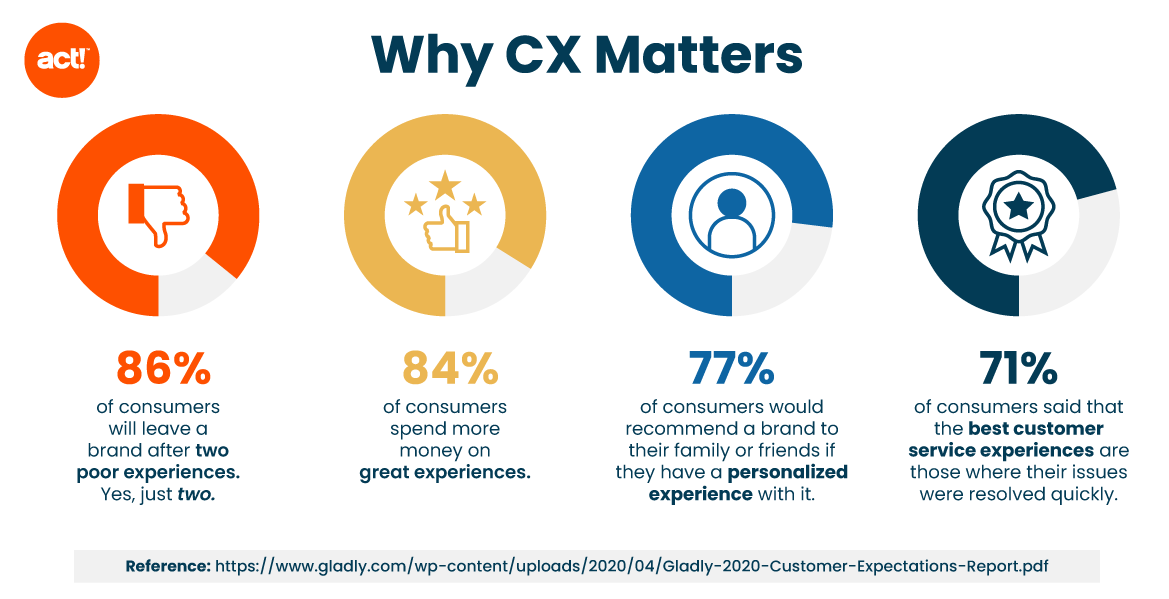Why would any customer or business want to buy from you? What gets them to stick around? The short answer: customer experience.
Think about it—would you rather buy from a business that personalizes its offerings for you or one that offers poor customer support? No prizes for guessing.
In fact, 86 percent of consumers will leave a brand if they have two poor experiences. That should be proof enough to tell you about the importance of customer experience.
But what exactly does it entail? And more importantly, how can you measure it? Let’s discover the answers to all that and more.
Customer experience defined
Simply put, customer experience (CX) encompasses the overall impression your brand makes on a new customer as they interact with it throughout their journey. This perception starts taking shape right from their first interaction with your brand as a prospect and keeps changing even when they become loyal customers.
It impacts the customer’s opinion of your brand and, thus, their likelihood of buying from you again or recommending you. When your customer-facing performance surpasses customers’ expectations, it’s a good customer experience. And that’s exactly what you should strive to achieve.
Why CX matters
Overall customer experience has become a central focus of companies for a good reason. Here’s why you must pay attention to it.
1. Helps you stand out
CX can be a key, real-time differentiator for your brand in a cluttered market. As brands compete for attention, the experience you offer can make your products and brand more appealing. Whether it’s a unique purchase experience or a happy customer’s testimonial, you can use it to promote your brand.
2. Wins customer loyalty
When you provide superior customer experiences, they’ll likely keep coming back to you for repeat purchases. Additionally, loyal customers may even recommend your brand to others, leading to greater customer acquisition. It also helps you increase your customer lifetime value (CLV).
3. Boosts brand reputation
Happy customers may share their experiences within their circles or online. It can have a ripple effect on your brand image and reputation. When other prospects come across reviews saying good things about your brand, they’ll form a positive image in their mind, leading to better word-of-mouth marketing.
4. Generates more sales
Here’s the thing—84 percent of consumers spend more money on great experiences. So, a vast majority of your customers might end up purchasing more from you, leading to greater sales and business growth.

Customer experience vs. customer service: What’s the difference?
Customer experience is often paired up with customer service. Although the two concepts are related, there are some key differences.
Customer service focuses on helping customers with their issues so they can better utilize your products. The way your support team provides service to your customers can affect the overall CX. But it’s not the only factor that influences it.
Instead, customer experience is a broader concept and includes every interaction customers have with your brand across multiple touchpoints. These include your website, payment process, product ease of use, and more. Customer service is only one of those customer touchpoints in their journey.
What makes up customer experience?
There are several facets involved in delivering stellar experiences to your customers. Here are the most important ones to consider for creating a customer experience strategy and improving your competitive advantage.
Personalization
Seventy-seven percent of consumers would recommend a brand to their family or friends if they have a personalized experience with it. It’s no surprise, then, that personalization makes up a major part of a great CX. And if you’re able to go above and beyond the basic personalization and meet customers’ needs, you can win them over.
That’s where a customer relationship management (CRM) tool comes in handy. It can help you understand customers’ perceptions and tailor your offerings and digital experiences for them accordingly. You can also use the relationship history and segmentation to personalize your interactions and messaging with them.
Resolution time and empathy
When customers reach out to you with their problems, they expect you to be empathetic. That’s why it’s crucial to show them that you understand their pain points. At the same time, they want quick resolutions. Case in point—in the same Gladly study, 71 percent of consumers said that the best customer service experiences are those where their issues were resolved quickly.
CRMs can help with this as well. They can bring all your previous customer interactions under one hub and help you search through the information quickly so you can understand their issues and resolve them quickly.
Value delivery
Your products or services must provide the promised value to your customers. They should be able to use them to attain their goals. So, be sure your products justify their price point and keep customers hooked.
You can also track customer activities using your CRM and reach out to them for product feedback. Note this customer feedback and make changes to your product or service to ensure value delivery.
Emotional connection
User experience also has a lot to do with building an emotional connection with your brand. Instead of looking at customers as mere numbers or steps for revenue growth, you must go beyond transactional interactions and make an effort to build genuine connections.
CRMs can help you provide personalized service and launch customized campaigns for your customers. This can help you remain connected to them and forge stronger relationships.
Consistency
Arguably the most important component of a great customer experience, consistency is crucial throughout the customer journey. Customers must feel they’re interacting with the same brand, whether as a prospect or as a loyal customer. It must also remain the same across multiple touchpoints and channels.
With a CRM, you can manage all your customer interactions from a single hub. At the same time, you must come up with a brand voice guide that can help you provide the same experience to your customers, regardless of their stage in the journey or the channel.
How to measure customer experience
By now, you might have a clear picture of the components of a positive customer experience. But to improve CX, you need to be able to measure it in the first place.
Based on the insights you get from measuring your CX, you can determine how to better implement customer experience management (CXM). Here’s how you can go about it.
1. Conduct surveys
You can cut the guessing game short by directly asking customers for feedback. Create surveys using a survey platform or your CRM and send them out to your customers. You can launch in-app surveys or choose to send them through email or other modes.
There are three major types of surveys you can conduct to get a clear understanding of your customer experience:
- Customer satisfaction (CSAT) survey: These surveys typically ask the customers about their satisfaction levels. You either provide them with a scale from 0 to 10 or let them select from “Very unsatisfied” to “Very satisfied.” A higher customer satisfaction score is a likely indicator of better customer experience.
- Net promoter score (NPS) survey: This survey helps you determine your brand loyalty and measures the likelihood of a customer recommending your brand to someone else. It typically involves a scale of 0 to 10 for the likelihood of recommendation. A higher score means customers are happy with your offerings.
- Customer effort score (CES) survey: It helps you measure customer experience by asking customers about the ease of using your product or service. The idea is that ease of use plays a major role in customer retention. You can use a scale of 0 to 10 or ask customers to agree or disagree with the statement about ease of use.
2. Analyze support ticket trends
You can use your CRM or ticketing software solution to track ticketing and support activities. The concept here is that customers choose to raise tickets or reach customer support only if they encounter issues. A lower ticket volume or number of support queries is indicative of superior customer experience, and vice-versa. Likewise, you can analyze the ticket data to see which issues are routinely popping up.
3. Analyze customer churn
Regardless of how fantastic your offerings and service level are, churn will always be there. But an increasing rate likely points toward a bad CX. To identify the reasons behind customer churn, you can launch exit surveys asking customers why they’re leaving your brand. Working on this feedback can help you prevent future churn.
4. Track your customer metrics
You can also monitor customer metrics like customer lifetime value (CLV), using your CRM to better understand your CX. A higher lifetime value means customers are sticking to your brand, which could be the result of a superior experience. You can also measure your retention rate and average resolution times (for customer service) to determine the state of your CX.
Start improving your customer experience
Customer experience plays a major role in your business growth, fueling retention and driving revenue growth. Start measuring your CX, and make changes to your CX strategy, to elevate customer satisfaction levels. And be sure to invest in the right set of tools to help you measure and improve customer experience.
Act! CRM can help you personalize your marketing and communications with customers. It can also reduce resolution time and bring in consistency through marketing automation. Start your free trial now to see how Act! will elevate your customer experience.
Customer experience FAQs
Customer experience is the overall impression your brand leaves on a customer throughout their lifecycle with your brand, right from the time they come across it to the end of their association with you. Every interaction they have with your brand contributes to the overall CX.
A great customer experience:
- Helps customers accomplish their goals and solve their problems
- Makes interactions with your brand seamless
- Delivers personalized and valuable services to customers
- Means customers can rely on your brand for their requirements
It’s the overall management of the customer experience throughout the sales funnel to ensure that your customers get a coherent, personalized, and consistent experience throughout their interactions with your brand. The aim of CXM is to elevate customer satisfaction levels.
Your goal should be to provide a personalized and consistent experience to your customers across every channel throughout their journey with your brand. A customer experience strategy defines the basis of your CX and ensures that everyone on your team is aligned toward achieving those goals.
Here’s what your business can do to enhance CX:
- Personalize your services for every customer and make them feel valued.
- Adopt an omnichannel approach for a consistent experience.
- Ensure your product solves your customers’ problems.
- Collect and act on customer feedback.
Want to learn more? Check out these related resources:

Articles









